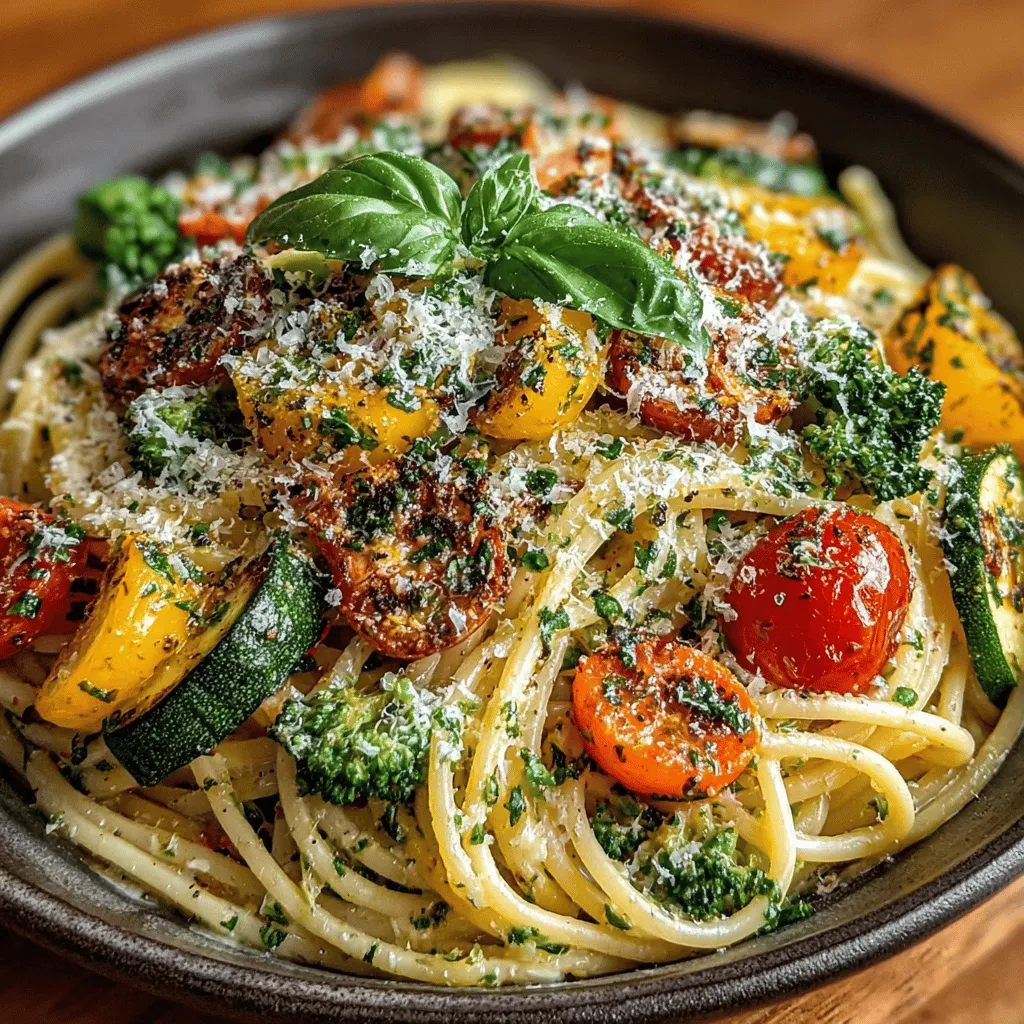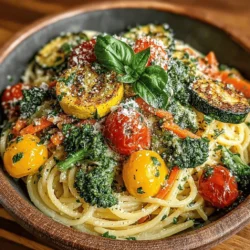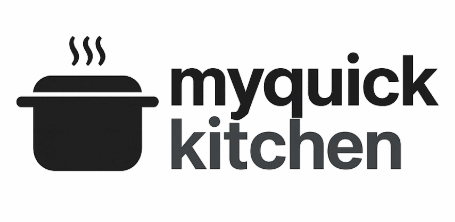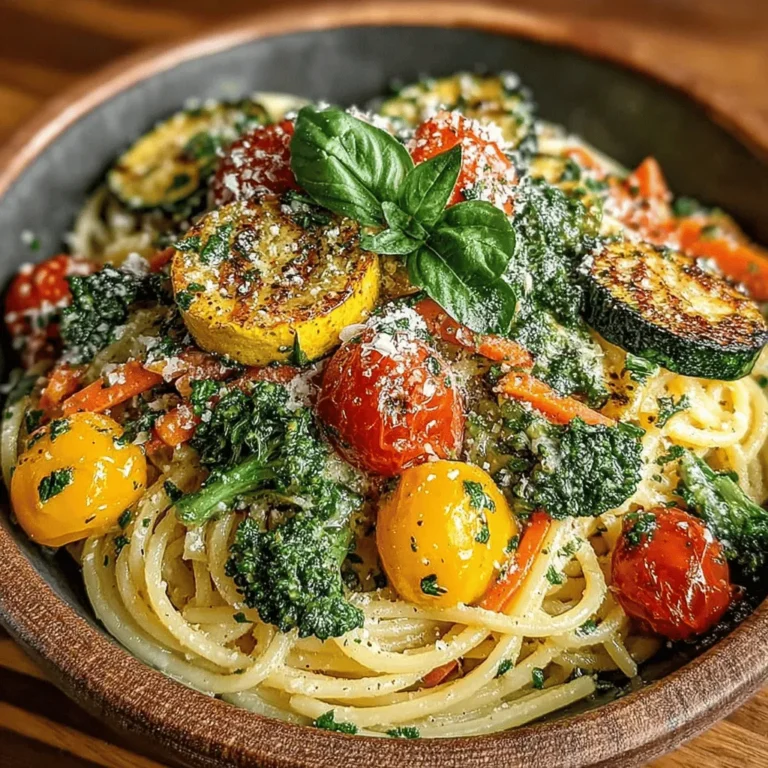Vibrant Pasta Primavera with Garlic Parmesan Sauce
Pasta Primavera is more than just a dish; it’s a celebration of the season’s freshest vegetables, artfully combined with al dente pasta and a creamy sauce that brings everything together. Originating from Italy, this delightful recipe showcases a variety of colorful vegetables, making it not only a visually appealing dish but also a powerhouse of flavors and nutrients. As more people seek to incorporate healthy eating habits into their lifestyles, Pasta Primavera stands out as a delicious option that doesn’t compromise on taste or satisfaction.
The key to a successful Pasta Primavera lies in the freshness of the ingredients. By utilizing seasonal vegetables, you not only enhance the dish’s flavor but also its nutritional profile. Seasonal vegetables are packed with vitamins and minerals, offering a fresh taste that can transport you to an Italian garden with each bite. In this recipe, we will also introduce a luscious Garlic Parmesan Sauce, which acts as a creamy complement to the array of vibrant vegetables, enhancing their natural sweetness and providing a satisfying creaminess.
Understanding Pasta Primavera
The term “Primavera” translates to “spring” in Italian, aptly naming this dish that celebrates the fresh produce of the season. While the exact origins of Pasta Primavera are somewhat debated, many attribute its creation to the rich culinary traditions of Italy, particularly in the mid-20th century. It gained popularity in the United States during the 1970s, where it was embraced for its lightness and the incorporation of fresh ingredients, aligning perfectly with the health-conscious movements of the time.
In Italian cuisine, the emphasis on using fresh, high-quality ingredients cannot be overstated. Each component of a dish plays a crucial role in flavor and texture; therefore, choosing fresh vegetables not only enhances the taste but also honors the culinary principles that Italian cooking is built upon. When you opt for a vegetable-rich pasta dish like Pasta Primavera, you are not only indulging in a meal that is pleasing to the palate but also one that is packed with nutritional benefits. Vegetables like zucchini, bell peppers, and cherry tomatoes are rich in vitamins A and C, fiber, and antioxidants, making this dish a wholesome choice.
Ingredients Breakdown
To create this vibrant Pasta Primavera with Garlic Parmesan Sauce, let’s take a closer look at the key ingredients that make this dish shine.
1. Pasta: The foundation of the dish. Opt for a quality pasta like fettuccine or penne that can hold onto the sauce and vegetables well.
2. Zucchini: This versatile vegetable adds a mild flavor and a lovely crunch. It absorbs the garlic and Parmesan flavors beautifully.
3. Bell Peppers: Choose a mix of colors—red, yellow, and green—for visual appeal and a range of flavors. They contribute sweetness and a satisfying texture.
4. Cherry Tomatoes: These small, juicy tomatoes burst with flavor when cooked, adding sweetness and a touch of acidity to balance the creaminess of the sauce.
5. Broccoli: A nutrient-dense vegetable that provides a delightful crunch and a boost of vitamins.
6. Carrots: Sliced thinly, they add a hint of sweetness and an appealing color contrast to the dish.
7. Garlic: The aromatic base for the sauce, infusing the dish with a warm, savory depth.
8. Parmesan Cheese: Freshly grated Parmesan is essential for the sauce, providing creaminess and a rich, savory flavor.
9. Olive Oil: A high-quality extra virgin olive oil is crucial for sautéing the vegetables and adds a fruity richness to the dish.
10. Optional Ingredients: For those who enjoy a bit of heat, red pepper flakes can be added. A squeeze of fresh lemon juice at the end brightens the flavors and adds a refreshing zest.
Step-by-Step Cooking Instructions
Now that we’ve gathered our ingredients, it’s time to dive into the cooking process. The first step in creating your vibrant Pasta Primavera is cooking the pasta.
Cooking the Pasta: Start by bringing a large pot of salted water to a rolling boil. The salt is vital—it enhances the flavor of the pasta as it cooks. Once boiling, add your chosen pasta and cook according to the package instructions until al dente, which means the pasta should be tender but still firm to the bite. This texture is crucial, as it will hold up well against the sautéed vegetables and the creamy sauce.
As the pasta cooks, it’s important to reserve some of the pasta water before draining. This starchy water can be a lifesaver when it comes to adjusting the consistency of the sauce later, allowing it to cling perfectly to the pasta and vegetables.
While your pasta is cooking, you can prepare the vegetables and the Garlic Parmesan Sauce. This multitasking not only saves time but also keeps your meal preparation seamless.
In a large skillet, heat a generous drizzle of olive oil over medium heat. Once the oil is shimmering, add minced garlic and sauté until fragrant, about 30 seconds. Be careful not to let it brown, as burnt garlic can impart a bitter taste.
Next, add your chopped vegetables starting with the ones that take longer to cook, such as broccoli and carrots. Sauté for a few minutes until they begin to soften, then add the zucchini and bell peppers. Cook until the vegetables are tender but still vibrant in color, ensuring they retain their crunch and nutrients. Finally, toss in the cherry tomatoes, allowing them to soften slightly and burst with flavor.
As the vegetables are cooking, it’s the perfect time to prepare the Garlic Parmesan Sauce. In a separate bowl, combine freshly grated Parmesan cheese with a splash of the reserved pasta water and some additional olive oil. Stir until you achieve a creamy consistency. You can also adjust the richness of the sauce by adding more cheese or water, depending on your preference.
With the pasta cooked and the vegetables sautéed to perfection, it’s time to bring everything together. Drain the pasta and add it directly to the skillet with the sautéed vegetables. Pour the Garlic Parmesan Sauce over the top, and toss everything gently to combine, ensuring that each strand of pasta and piece of vegetable is coated in the creamy sauce.
At this stage, feel free to taste and adjust the seasoning. A sprinkle of salt, freshly cracked black pepper, and optional red pepper flakes can elevate the dish further. If you like a bit of brightness, a squeeze of fresh lemon juice can work wonders, enhancing the flavors of the vegetables and cutting through the richness of the sauce.
Stay tuned for the next part, where we’ll explore serving suggestions, variations, and tips for making this dish your own.

Sautéing the Vegetables
To achieve the perfect texture and flavor balance in your Pasta Primavera, sautéing the vegetables is a crucial step. Begin by choosing a mix of colorful vegetables such as bell peppers, zucchini, asparagus, and cherry tomatoes. These not only add vibrant colors but also different textures and flavors.
When sautéing, it’s important to start with the denser vegetables first, as they require more cooking time. For example, begin with bell peppers and carrots, cooking them for about 3-4 minutes until they start to soften. Then, add zucchini and asparagus, continuing to sauté for another 2-3 minutes until they are tender but still crisp. The key here is to maintain a balance; you want the vegetables to be cooked through yet retain their shape and a slight crunch, avoiding the mushy texture that can ruin the dish.
Using a large skillet or sauté pan helps ensure that the vegetables cook evenly without overcrowding. A splash of olive oil at the beginning allows the vegetables to caramelize, enhancing their natural sweetness and flavor. Stir them occasionally to ensure even cooking and prevent burning.
Adding Garlic
Garlic is a star ingredient in this dish, providing aromatic depth and flavor. To ensure you achieve the perfect balance without burning the garlic, which can turn bitter, add it to the pan after the denser vegetables have had a chance to soften. Mince the garlic finely, and add it to the pan for the last 1-2 minutes of cooking the vegetables.
Keep the heat at medium to medium-low while adding the garlic, stirring frequently. This will allow the garlic to infuse its flavor into the vegetables while preventing it from burning. Once the garlic becomes fragrant, it’s a signal that it’s time to move on to the next step.
Preparing the Creamy Garlic Parmesan Sauce
Creating a smooth and creamy Garlic Parmesan Sauce is the next step toward elevating your Pasta Primavera. In a separate saucepan, melt butter over medium heat. Once melted, whisk in flour to create a roux, cooking for about 1-2 minutes until it turns a light golden color. This will help thicken your sauce while adding depth to its flavor.
Gradually whisk in milk or heavy cream, ensuring there are no lumps. Continue to whisk until the mixture thickens and bubbles gently. Once thickened, reduce the heat to low and stir in freshly grated Parmesan cheese, allowing it to melt and create a creamy consistency. For added flavor, season the sauce with salt, pepper, and a pinch of garlic powder if desired. If the sauce is too thick, you can adjust it by adding a bit more milk or cream until the desired consistency is reached.
Combining the Pasta and Sauce
Once your pasta is cooked to al dente and drained, it’s time to bring everything together. In the skillet with the sautéed vegetables, add the pasta directly. Pour the creamy Garlic Parmesan Sauce over the pasta and vegetables, gently tossing to combine. This ensures that every strand of pasta is coated in sauce, and the vegetables are evenly distributed throughout the dish.
Use tongs to mix the pasta and sauce thoroughly, allowing the heat of the pasta to warm the sauce slightly. This will enhance the overall flavor and help the sauce cling to the pasta beautifully. Taste and adjust seasoning as needed, adding more salt, pepper, or even a touch of red pepper flakes for a bit of heat.
Final Seasoning
The finishing touch to your vibrant Pasta Primavera is the addition of fresh lemon zest and juice. The brightness from the lemon will elevate the dish, cutting through the richness of the creamy sauce. Grate the zest of one lemon directly into the pasta mixture, then squeeze in the juice, making sure to avoid any seeds. Toss everything together one last time to combine the flavors.
Serving Suggestions
With your vibrant Pasta Primavera ready, it’s time to think about how to serve it. Creative plating can enhance the visual appeal of your dish. Consider serving the pasta in shallow bowls or on large plates, garnishing with additional grated Parmesan and a sprinkle of fresh herbs like basil or parsley. This not only adds color but also freshness to the dish.
For pairing suggestions, consider serving a simple mixed green salad with a light vinaigrette alongside your Pasta Primavera. This will complement the meal without overwhelming it. As for wine, a crisp white wine, such as Sauvignon Blanc or Pinot Grigio, pairs well with the light and fresh flavors of the dish.
Discussing Variations
One of the best aspects of Pasta Primavera is its versatility. Feel free to customize the dish based on seasonal produce or personal preferences. In the spring, consider adding peas or fava beans for a fresh pop of color and sweetness. In the summer, incorporate roasted cherry tomatoes or grilled zucchini for a smoky flavor.
You can also experiment with different types of pasta; while traditional spaghetti or fettuccine works well, try whole wheat or gluten-free options to suit dietary needs. For a protein boost, add grilled chicken, shrimp, or chickpeas.
Nutritional Information
Understanding the nutritional content of your dish can be just as important as crafting the perfect flavor profile. On average, a serving of Pasta Primavera with Garlic Parmesan Sauce contains approximately 450-500 calories, depending on the specific ingredients and portion sizes.
This dish is packed with vitamins and minerals due to its array of colorful vegetables, providing dietary fiber, vitamin C, and antioxidants. By using whole ingredients, such as fresh vegetables and natural cheeses, you ensure that your meal is not only delicious but also nutritious. Avoiding processed ingredients helps in reducing the intake of unhealthy fats and preservatives, making this a wholesome choice for your dining table.
Conclusion
Pasta Primavera with Garlic Parmesan Sauce is a delightful, versatile dish that showcases the beauty of fresh ingredients. Whether you’re preparing a weeknight dinner, hosting a gathering, or simply indulging in a comforting meal, this recipe fits the bill perfectly. The joy of cooking with fresh produce and the satisfaction of a homemade meal are experiences that should not be overlooked.
Don’t hesitate to experiment with different vegetables and flavor combinations, making this dish uniquely yours. The beauty of Pasta Primavera lies in its adaptability to the seasons and your personal taste preferences. So gather your ingredients, unleash your creativity, and enjoy the vibrant flavors and colors of this wonderful dish!


